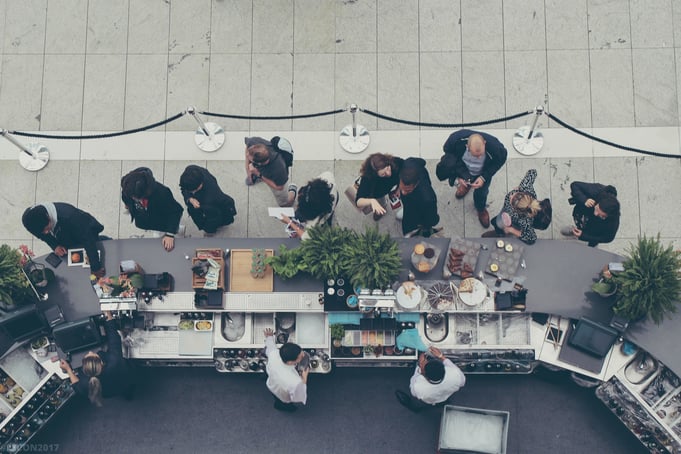
The notion of customer experience has increased in importance over the past years. Indeed, it has become one of the buzzwords of the current marketing generation and more and more CMOs consider it a top priority for their company (The Marketer’s Toolkit 2019, Warc).
A superior customer experience reduces churn, and boosts acquisition through referrals, word of mouth and customer reviews.
When digital transformations took off, the customer experience became hot. The fact is today the online offer of services and products has never been greater. Brands have to stand out in order to establish a competitive advantage: enter customer experience. Brands that excel in customer experience win nowadays. Think of Coolblue, Bol.com, Uber, Booking.com, Netflix …
But what about the physical customer experience? The customer experience in the real world is difficult to control because there are lots of variables that brands have little to no control over. In this article you’ll learn 3 ways of improving your physical customer experience.
Of course, these are also applicable online.
1. Peak-end rule
The peak–end rule is a psychological bias that professors in psychology Kahneman & Tversky described in 1999. The peak-end rule states that people remember an experience, whether it’s negative or positive, based on how they felt at its peak and how they feel at its end, instead of judging the experience as a whole.
The peak-end rule has important implications for your customer journey. When you’re designing your customer journey, it is crucial to do at least 2 things: create at least one standout peak experience in the journey and make sure you end the experience with a blast.
The peak-end rule states that people remember an experience, whether it’s negative or positive, based on how they felt at its peak and how they feel at its end.
For example: the Magic Castle Hotel in Los Angeles. On Tripadvisor, it is currently ranked as the 5th best hotel in Los Angeles.
At first sight, the hotel looks rather old fashioned and a bit expensive. So how does the Magic Castle Hotel stand out?
It has a popsicle helpline.
This means that anytime, day or night, you can order a free popsicle through a red phone next to the pool. Within minutes a butler, sporting white gloves and a silver platter, will be on hand to offer a wide variety of free ice-lollies.
Take-away: how can I improve your my interaction with my customer or create a peak-moment during the experience?
2. Remove negative experiences by changing the context
Some content marketers claim that content is king. But they made a spelling mistake and switched the x for an n, because context is king! The context in which experiences are perceived is extremely important and can change a bad experience into a good one and vice versa.
Here’s a good example.
A couple of years ago Houston Airport got a lot of complaints from passengers. They weren’t satisfied with the waiting time at the baggage carousel.
After huge investments Houston Airport was able to reduce the waiting time to just 8 minutes, the national average. But still complaints kept on coming.
The fact was passengers walked just 1 minute to the carrousel and then waited there for 8 minutes until their luggage appeared. Houston airport couldn’t reduce the waiting time at the baggage carousel anymore, but they could change the context. In the end, the airport changed the route passengers took to get to the baggage carousel.
Passengers now walked for 8 minutes, and only had to wait for 1 minute at the carousel. This small intervention resulted in increased customer satisfaction, even though the overall result stayed the same: it still took 9 minutes for passengers to claim their luggage.
Take-away: search for frustrations in your customers’ journey and try to remove them by changing the context for your customers.
3. Surprise and delight your customers with random acts of kindness
According to a definition on ‘goodtherapy.com’ a random act of kindness is: “a selfless act, both large and small, that is committed unexpectedly, without prompting and with no apparent ulterior motive. Such as paying for a coffee for the person in line behind you.”
In marketing ‘a random act of kindness’ is of course not so random and most probably will happen with a clear ulterior motive. Companies give something of value to a targeted selection of prospects or customers hoping that they convert them into customers, or that they buy something extra or give the company a good review.
Random acts of kindness are based on the reciprocity bias that Professor in psychology, Robert Cialidini describes in his book ‘Influence’. The reciprocity bias states that people feel indebted to those who do something for them or give them a gift. Give information, give free samples, give a positive experience to people and they will want to give you something in return. You feel obligated to repay. It's an almost automatic instinctive reaction.
The reciprocity bias states that people feel indebted to those who do something for them or give them a gift.
Think of the ‘free’ Limoncello you get at your favourite Italian restaurant. Afterwards you’ll give a bigger tip (and not because of the alcohol), or you’ll tell all your friends about that awesome little place with great pizzas and Limoncello at the end (remember the peak-end rule).
Take-away: surprise your customers with a ‘random’ act of kindness and they will feel obliged to give you something back: a 5-star rating, an extra visit, spend more money or they will bring a friend (aka a new customer ;) ) next time.
95% of the people who pre-read this article thought it was interesting and useful. Including a CEO, 3 CMOs and 2 creative directors.
Need some help?
Curious about the psychological biases I just described and how those biases can help your business? Let’s grab a coffee together.
Written by Samuel Eggermont, Junior Strategic Planner
#biking #apresskihits #JohhnyDäpp
Filed under INSPIRATION